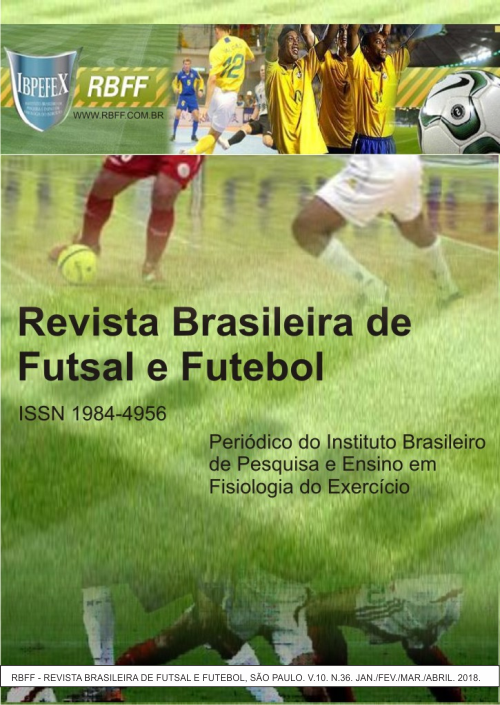Estácio FIC/FUT3 Project: What it represents for teenagers
Abstract
The sport adds several values to its participants as collectivism, friendship and solidarity, being these values indispensable for their lives. Members of lower income social classes tend to have sport as a form of social upward mobility, and as such may represent self-fulfillment, since many live in areas that do not provide them with the right to a full citizenship. Football has great influence on its practitioners, since they require great changes in postures as a person and an athlete. Today, the athlete living in an area of risk has the possibility, through sport, of having access to a quality school, having a healthy relationship with other young people, learning to respect rules and hierarchy. This young may not even become an athlete, but through sport he will have all the tools to become a complete citizen. The aim of the present study was to investigate the influence of the Estácio FIC/FUT3 Football Project and football in the life of adolescents. Interviews were conducted with 15 adolescents between 14 and 17 years old who participated in the Estácio FIC / FUT3 Football Project. After transcribed, the interviews were submitted to the Content Analysis methodology that found the following contents: Drugs and bad friendships; social welfare and school; Better future. One can conclude that the great demand for a football project is due to the dream of opportunities. Through the project there is the reintegration of these young people into society, a behavioral change and the creation of a citizen who sees in sport a possibility of change of life and conduct.
References
-Alcântara, H. A magia do futebol. Estudos avançados. Vol. 20. Núm. 57. p. 297-313. 2006.
-Borsari, J. R. Futebol de campo. São Paulo. EPU. 1989. p. 82.
-Brasil. Estatuto da criança e do adolescente. 2013. Disponível em: <http://www.alesc.sc.gov.br/portal/docs/eca.pdf > Acesso em: 01/05/2015.
-Cadoti, M. Qualidade na educação: uma nova abordagem, In: Congresso de Educação Básica: Qualidade na aprendizagem. 2013 Florianópolis. Anais... Florianópolis. 2013.
-Capelinha, J. A qualidade das relações de amizade na adolescência e suas implicações ao nível do autoconceito e da auto-estima. Dissertação de Mestrado em Psicologia. Instituto Universitário Ciências Psicológicas, sociais e da vida. Lisboa. 2013.
-Centro Brasileiro De Informações Sobre Drogas. Consumo de Drogas-CEBRID.2010. Disponível: <http://www.cebrid.epm.br/index.php>. Acessado em: 25/03/2015.
-Chaves, W. M. Cultura, valores e Educação Física escolar. VIII Encontro Fluminense de Educação Física Escolar, 08,2004, Niteroi-RJ. Anais... Niteroi-RJ. Universidade Federal Fluminense. 2004. p. 174-177.
-Cruz, A. R. Futebol Brasileiro: um caminho para a inclusão social. São Paulo. Esfera. 2003. p. 112.
-FIFA. Federation International De Football Association. Grande contagem FIFA 2006: 270 milhões de pessoas ativas no futebol. Disponível em:<http://www.fifa.com/mm/document/fifafacts/bcoffsurv/bigcount.statspackage_7024.pdf> Acesso em: 07/04/2015.
-Mafra, J. Inclusão Social. Brasil Escola, 2007. Disponível em: <http://www.brasilescola.com/educacao/inclusao-social.htm>. Acesso em: 12/04/2014.
-Matheus, T. C.O discurso adolescente numa sociedade na virada do século. Psicologia USP. Vol. 14. Núm. 1. 2003.
-Miranda, R.; Filho, M. Construindo um atleta vencedor: uma abordagem psicofísica do esporte. Artmed. 2008. p. 141-154
-Murad, M. F. Para entender a violência no futebol. Benvirá. 2012. p. 237.
-Oliveira, M. Futebol: perspectiva de inclusão e ascensão social. In: Congresso Regional de Educadores. 2008. Uberaba. Anais... Uberaba. 2008.
-Paim, M. C. C. Fatores motivacionais e desempenho no futebol. Revista da Educação Física/UEM. Vol. 12. Núm. 2. p. 73-79. 2001.
-Paiva, A. R. Juventude, cultura cívica e cidadania. Garamond, 2013. p. 27-35.
Authors who publish in this journal agree to the following terms:
- Authors retain the copyright and grant the journal the right of first publication, with work simultaneously licensed under the Creative Commons Attribution License BY-NC which allows the sharing of the work with acknowledgment of the authorship of the work and initial publication in this journal.
- Authors are authorized to enter into additional contracts separately for non-exclusive distribution of the version of the work published in this journal (eg, publishing in institutional repository or book chapter), with acknowledgment of authorship and initial publication in this journal.
- Authors are allowed and encouraged to post and distribute their work online (eg, in institutional repositories or on their personal page) at any point before or during the editorial process, as this can bring about productive change as well as increase impact and impact. citation of published work (See The Effect of Free Access).





